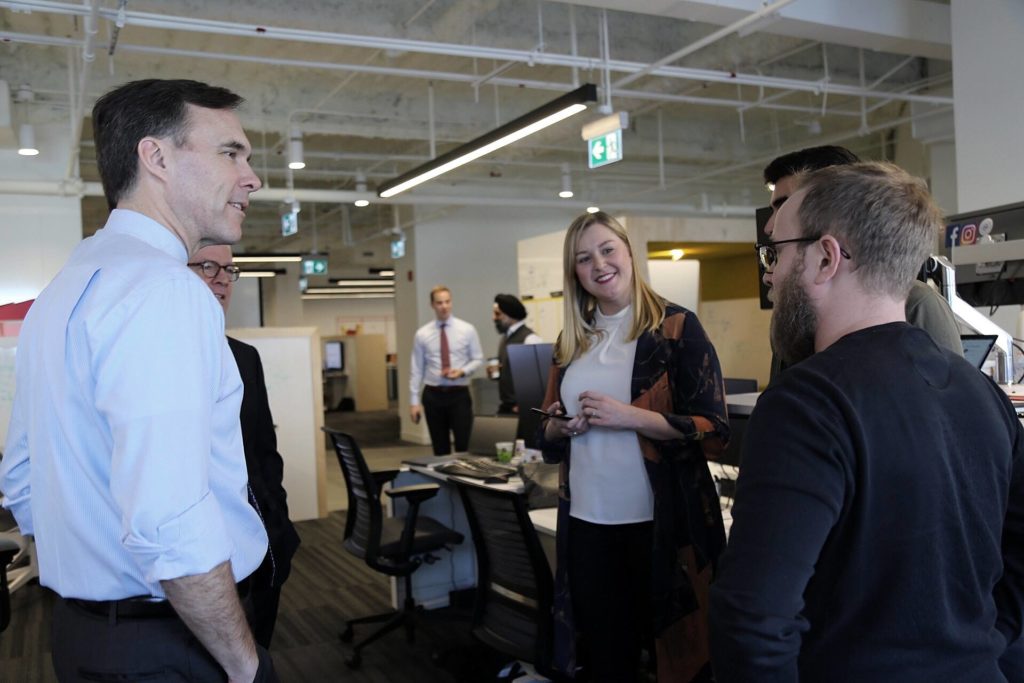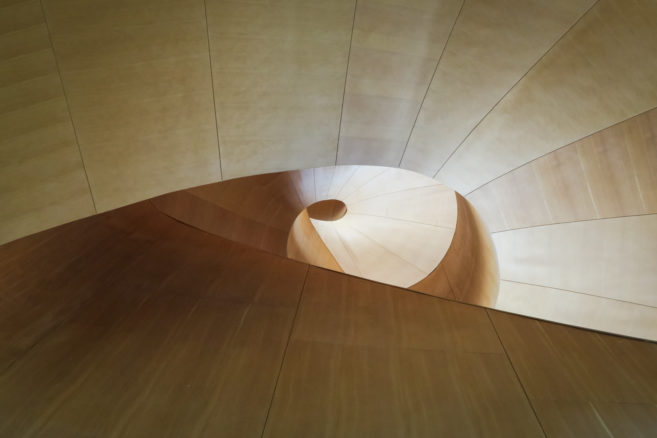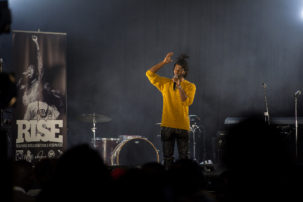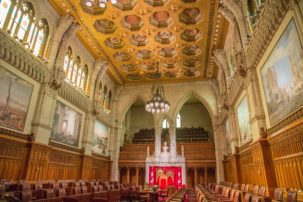This week, the federal government’s 2018 budget was released with a big push on equity (or “Equality + Growth” as the actual title of the budget document begins). It’s a welcome theme for many in the arts community who have long been concerned about discrimination, harassment and unequal pay in the cultural sector and beyond. But at the same time, some were wondering where the arts were at all in the new budget. Here’s what some leading arts advocacy experts have identified as a few key wins and losses for Canada’s artists and arts organizations.
1. “If the goal was to highlight precarious workers, the federal government may have missed an opportunity to recognize the role that 650,000 cultural workers play in the Canadian economy.”
The sentiment of the quote above, provided by the Canadian Arts Coalition’s Budget 2018 press release, was shared by others in the arts advocacy community.
“I would say this federal budget is a fairly timid budget,” says John McAvity of the Canadian Museums Association. “I saw very little reference to culture in it. And I saw no references to the Heritage Minister’s Creative Canada, which was her big announcement back in September. And I saw very little in this budget for the creative community.”
Granted, the fact that the words “Creative Canada” and related topics were nowhere to be seen in Budget 2018 may have had to do with the massive thud with which that fall policy announcement went over. But even if Creative Canada was a PR fail for the government, the arts sector still needs support—particularly if precarity and marginalization is one of the topics the budget sought to address.
“The Canadian Arts Coalition is surprised by Budget 2018’s oversight of artists,” begins the Budget 2018 press release from the group. “Based on the Statistical Profile of Artists and Cultural Workers in Canada, the average income of artists is 32% lower than other workers.”
2. On the plus side, the budget’s investments in intellectual property rights—as well as an already slated copyright review—could stand to benefit many artists in Canada, and also help fight cultural appropriation.
Many Canadians have likely heard of headline-making intellectual property cases where an artist’s work has been stolen from Instagram and landed on a T-shirt sold by a major corporation, or on a piece of decor in a fancy restaurant—without any royalties paid to the artist. But many Canadians still do not know that in this country, even something as basic as exhibition fees for artworks are paid out in relation to the Copyright Act and intellectual property principles.
That means that Budget 2018’s emphasis on bolstering intellectual property supports and regulations could have many positive impacts on artists in Canada. “The exhibition fees and reproduction rates and all those are copyright,” says April Britski of Canadian Artists’ Representation/Le Front des artistes canadiens (CARFAC). “So the fact that they are reviewing copyright and putting money into targeted areas is good news.”
Budget 2018’s emphasis on intellectual property “is interesting because we’re just about to go into a big review of the Copyright Act” too, notes Britski. Among the promised spending boosts are $2 million over 3 years for Statistics Canada to study how Canadians understand and use intellectual property; $33.8 million over 5 years to Innovation, Science and Economic Development Canada, $4.5 million of which is earmarked for the creation of an intellectual property marketplace; $5 million for a new intellectual property strategy at the Copyright Board of Canada; and money for a new digital strategy fund.
“I also notice that they have $21.5 million over five years so that Canadian entrepreneurs can access intellectual property legal clinics at universities,” says Britski. “I know there are at least six artist legal clinics across Canada, so I’m interested to find out how they might be able to work with this.”
Also notable on the front of fighting cultural appropriation is a budget line of $1 million over 5 years to participate in research about intellectual property and traditional knowledge. “When you are talking about imagery that has a long tradition of being used in communities, but there is not a single copyright owner, figuring out how to [defend that intellectual property] in legislation is a good move,” says Britski.
3. Arts organizations of all sizes could also gain staff resources thanks to increases in the Canada Summer Jobs program.
Starting in 2018–19, the new federal budget promises that $448.5 million will be provided over five years to the Canada Summer Jobs program—a program upon which many arts and culture organizations depend. Both John McAvity of the Canadian Museums Association and Anne Bertrand of the Artist-Run Centres and Collectives Conference said that was a positive.
That’s because organizations ranging from large museums to small artist-run centres often need to engage this jobs program in order to accomplish tasks including visitor services, maintaining and managing archives, working on publications and more. In the ideal scenario, the Canada Summer Jobs program also provides youth in the cultural sector with much-needed and adequately paid work experience.
4. The federal budget’s focus on gender equity and Indigenous communities, as well as resetting pension age, could also benefit many artists.
“As a female arts advocate, I am pleased to see this focus on women in Budget 2018,” says Kate Cornell of the Canadian Arts Coalition. “We were also encouraged by the funding to confront gender-based harassment”—even though, she notes, “we were hoping to see it addressed in the arts and culture sector specifically.” (Given recent high-profile harassment cases such as Albert Schulz at Soulpepper in Toronto, art collector Francois Odermatt in Montreal, and Michael Coleman at SchoolCreative: Institute of the Arts in Vancouver, a specific anti-harassment initiative in the arts is likely needed.)
The budget’s focus on equity and Indigenous rights was well-received by other arts groups too. “Our members remain sensitive to equity and the budget makes a lot of promises in terms of the challenges faced,” says Anne Bertrand of ARCA. Bertrand also notes that the budget’s lowering of Old Age Security and Guaranteed Income Supplement for Seniors eligibility age to 65 stands to stabilize income for some older artists. “Under Harper, the eligibility age went up to 67,” notes Bertrand. The shift back to 65 means “we can aspire to regular income in the next few years after a lifetime of precarious gigs.”
And funding boosts to multiculturalism programs at the Department of Canadian Heritage, as well as the Action Plan for Official Languages, could be of benefit to some artists and arts organizations. The new $400 million in official-languages funds over the next 5 years, for instance, “could have some repercussions for [French-language artist-run centres] in New Brunswick, Ontario, Manitoba, Alberta and maybe even BC,” Bertrand notes.
Meanwhile, the Canadian Museums Association states that “we are encouraged by the $23.9 million that will be provided to Parks Canada over five years to integrate Indigenous views, history and heritage into national parks and other sites.”
5. However, there is no mention in the budget of an Artist Resale Right—a long-hoped-for regulation that relates explicitly to intellectual property and that stands to benefit Indigenous artists in particular.
“Obviously, given that they put so much money into intellectual property, we are disappointed there is nothing in there about the Artist Resale Right,” says April Britski of CARFAC. The resale right, recommended by the Berne Convention for the Protection of Literary and Artistic Works and already in effect in at least 93 other countries, would see artists receive a 5% royalty when their works are resold.
Indigenous artists in particular are affected by the lack of resale right in Canada. “For example,” says CARFAC’s website, “Inuit artist Kenojuak Ashevak sold her piece Enchanted Owl in 1960 for $24. It was later resold [in 2001] for $58,650.” Ashevak, who was then in her mid-70s, got nothing from the resale. Another piece of evidence for the right: since the Artist Resale Right was introduced in Australia in 2010, the majority of artists receiving royalties—more than 63%—are listed as Aboriginal or Torres Strait Islander artists.
Britski adds that an announcement of an Artist Resale Right would cost the government little, yet benefit artists much. And ultimately, it is possible Canada will be forced into the right at some point. The World Intellectual Property Organization, which Canada joined back in 1970, held a conference on resale rights in 2017 and is looking at making it mandatory for member countries in future.
6. And some forms of museum funding still remain at levels lower than they were 1972. That’s right: 1972.
In 1972, Canada’s Museums Assistance Program was founded with an annual budget of $7 million. Today, despite repeated requests that the budget for this program be increased, it is sitting at $6 million—$1 million less than when it started 46 years ago. That impacts “everything from digitization to reconciliation to public programming to capital improvements” at Canada’s museums, says John McAvity of the Canadian Museums Association. “It’s a very broad, wide-ranging program”—but it needs increased resources to make those goals happen.
McAvity is hoping that discussions the CMA initiated in December 2017 with the Department of Canadian Heritage will help advance this funding in the 2019 budget. But there are also two other museum initiatives he hasn’t seen movement on, and is hoping to advance.
“The Standing Committee on Finance recommended that museums be included in the Endowment Incentives Program at the Department of Canadian Heritage,” says McAvity. The program is already used by performing arts organizations and other groups to stabilize their funding—but museums need to be part of the picture too. “On top of that, the CMA has had a longstanding request for a matching tax incentive for donations to museums,” says McAvity. And there was nothing in Budget 2018 about that, either.
7. Further, it’s worth noting that while the promises made in 2016 to double the Canada Council’s budget are still on track, that full doubling isn’t slated to happen until 2020–21—after the next federal election.
While arts groups are pleased that funding seems to be staying on track for the feds’ 2016 promise to double the budget of the Canada Council from roughly $180 million to $360 million, it is worth remembering that the increase is gradual over five years, and that full doubling actually isn’t due to take effect until 2020–21.
That’s after the next federal election. And it’s one of many budget promises that can be hard to parse given their multi-year designations, especially when promises stretch past an election cycle. So if all is going according to initial 2016 stepped-increases promises, the Canada Council budget increase for 2018–19 is $35 million compared to last year, bringing total budget to about $290 million—still $70 million away from the $360 million target.
8. What’s more, it’s still unclear how the new Canada Council funding will actually trickle down to artists and art organizations given that the council’s current funding model has only come into effect this year.
This past year has been the first one for the Canada Council’s new funding model, and several groups are still trying to understand how their funding might be impacted by the new sets of criteria and new assessment processes on deck.
On the plus side, the Canada Council’s new model is trying to ensure 25% of the new funds will go to artists, collectives or organizations who are new recipients or receiving core funding for the first time, particularly organizations targeted by Canada Council’s equity measures.
For organizations currently funded by the council, the impacts are less clear. “There’s been interesting increases” to funding for some artist-run centres so far under the council’s new funding model says Anne Bertrand of ARCA, “but not the significant increases we were hoping for. Only a few organizations received high-impact increases; most received just the sprinkling we have come to expect.” So overall, “there is not the impact hat our organizations were expecting, despite a few exceptions.”
The Artist-Run Centres and Collectives Conference has itself been put under pressure by the new Canada Council funding model, as the new model states that organizations like ARCA can receive no more than 60% of budget from the Canada Council, and right now ARCA is at 92%. “I found myself, this year, chasing money all year,” says Bertrand. “60% of overall budget might seem like a regular amount, but for arts advocacy groups, unless we become service providers charging fees for services, well, it can be very hard to get new sources of funding.”
9. And if the feds want to meet the Budget 2018 commitments they set out around trade, especially in the culture sector, it needs to look at supporting arts presenters at home.
There was a lot of talk about trade in Budget 2018. But in the cultural sector, some are asking a question: How can there be cultural goods to export if there is not enough support at home to prepare tour-ready performances, artworks and exhibitions?
“What we have been arguing is that before we can have a cultural export strategy, we have to be able to develop our artwork at home,” says Kate Cornell of the Canadian Arts Coalition. “The example in my field of dance is you can’t just create a work of dance and then decide you can take it to 10 different countries internationally,” says Cornell. “You really have to have more than one production period and for a country like Canada that means touring and developing the piece [domestically] so that you are ready for those international markets, like China.”
April Britski of CARFAC also notes some of the classic programs used to promote Canadian arts abroad are still AWOL. “We also found it disappointing that programs like Trade Routes and ProMart have not been reinstated,” in the new budget, Britski says. Those programs were cut by the Harper government in 2008, and they used to funnel upwards of $13 million annually to internationally touring arts initiatives.
Also on a trade-related note, the Artist Resale Right, not seen in this year’s budget, is important for international trade, says Britski. “Reciprocity between nations is needed,” says Britski. “France has the right and so does Australia, so if a French artist has a resale in Australia they get royalties sent back, and vice versa. But if the same artist had a resale in Canada, that artist gets no royalties, and same if a Canadian has a resale in France.”
10. The final analysis: It’s already time to start working on advocacy for arts and artists in next year’s budget and beyond.
“We know in the cycle of government, next year will mostly likely be a spending budget, because it is an election year,” says Kate Cornell of the Canadian Arts Coalition.
But nothing can be taken for granted, and arts advocacy groups are already gearing up for the coming year and beyond. For instance, some advocates are closely watching the Standing Committee on Canadian Heritage right now—for good reason. Just this week, amid budget hoopla, the committee quietly resumed its study on the state of Canadian museums. The study is hoped to “result in significant recommendations” for the museum sector, says John McCavity.
And over in the Senate, advocates are also tracking initiatives looking at issues like income precarity for artists in Canada, as well as the arts economy.
At the very least, arts groups want to make sure make sure promises like the Canada Council budget boosts go through in 2020–2021 no matter who is in power. “We are already starting to talk about election platforms and where we are going to go post-October 2019,” says Kate Cornell of the Canadian Arts Coalition. Cornell also noted that the coalition is planning its annual Arts Day on the Hill for October 2018. And other organizations are following suit.
“The Canadian Museums Association normally does a Hill Day, and we did not do one this past year—but we will be doing on this coming year in late November or December,” says John McAvity of the CMA. “We would love to have all advocates present.”
This post was corrected on February 28, 2018. The original copy erroneously identified the 2018–2019 Canada Council budget as being in the $250 million range, and therefore roughly $100 million short of the full budget doubling promised in 2016 for 2020–21. In fact, the 2018–19 Canada Council budget is in the $290 million range, and therefore only roughly $70 million short of the full doubling that was promised in 2016 for 2020–21. The text was also changed to more clearly convey that the Council budget doubling was always planned to roll out as an incremental stepped-increases process, with gradual increases every year until 2020–21.

 Finance Minister Bill Morneau at the Digital Factory in Toronto in February 2018. He tweeted that there was "no shortage of creativity and innovation" at that site. But where are the arts in his 2018 budget?
Finance Minister Bill Morneau at the Digital Factory in Toronto in February 2018. He tweeted that there was "no shortage of creativity and innovation" at that site. But where are the arts in his 2018 budget?







